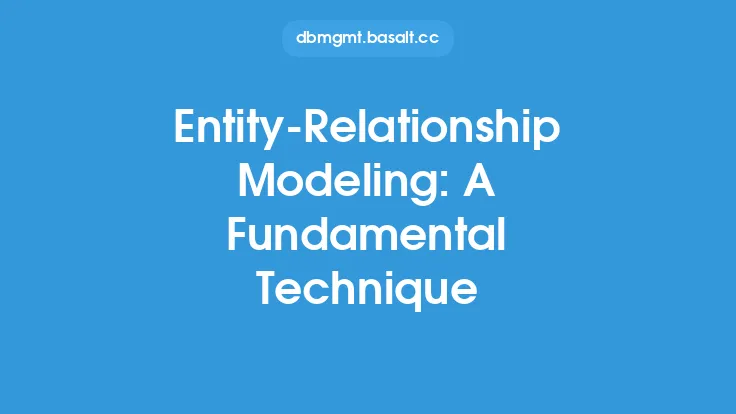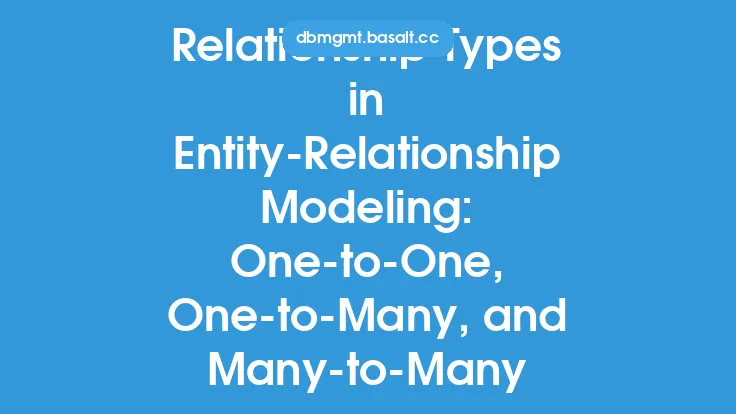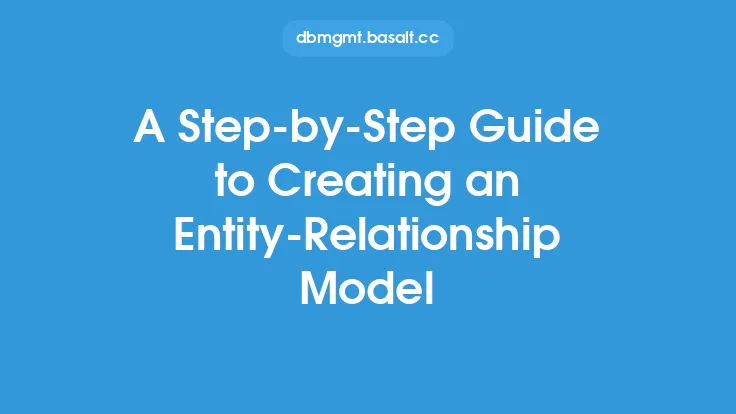Entity-Relationship Diagrams (ERDs) are a fundamental tool in database design, providing a visual representation of the structure of a database. They are used to model the relationships between different entities, such as tables, and to identify the attributes and relationships that define those entities. ERDs are a crucial step in the database design process, as they help to ensure that the database is well-organized, efficient, and easy to maintain.
Introduction to Entity-Relationship Diagrams
An ERD is a graphical representation of the entities, attributes, and relationships in a database. It is a diagram that shows the relationships between different entities, such as tables, and the attributes that define those entities. ERDs are typically used in the early stages of database design, as they help to identify the key entities and relationships that will be used in the database. They are also used to communicate the design of the database to stakeholders and to ensure that the database is well-organized and efficient.
Components of an Entity-Relationship Diagram
An ERD consists of several key components, including entities, attributes, and relationships. Entities are the tables or objects that are being modeled, and they are typically represented by rectangles. Attributes are the individual elements of data that are stored in each entity, and they are typically represented by columns or fields. Relationships are the connections between entities, and they are typically represented by lines or arrows.
Types of Entities
There are several types of entities that can be included in an ERD, including strong entities, weak entities, and associative entities. Strong entities are entities that have a unique identifier and can exist independently. Weak entities are entities that do not have a unique identifier and cannot exist independently. Associative entities are entities that represent a relationship between two or more other entities.
Types of Attributes
There are several types of attributes that can be included in an ERD, including simple attributes, composite attributes, and multivalued attributes. Simple attributes are individual elements of data that are stored in each entity. Composite attributes are attributes that are made up of multiple simple attributes. Multivalued attributes are attributes that can have multiple values.
Types of Relationships
There are several types of relationships that can be included in an ERD, including one-to-one, one-to-many, and many-to-many relationships. One-to-one relationships occur when one entity is related to only one other entity. One-to-many relationships occur when one entity is related to multiple other entities. Many-to-many relationships occur when multiple entities are related to multiple other entities.
Creating an Entity-Relationship Diagram
Creating an ERD involves several steps, including identifying the entities, attributes, and relationships that will be included in the diagram. The first step is to identify the key entities that will be used in the database. The next step is to identify the attributes that define each entity. The final step is to identify the relationships between the entities and to draw the ERD.
Benefits of Entity-Relationship Diagrams
ERDs have several benefits, including improved communication, increased efficiency, and better data integrity. They provide a clear and concise visual representation of the database structure, making it easier for stakeholders to understand the design of the database. They also help to ensure that the database is well-organized and efficient, which can improve performance and reduce maintenance costs. Finally, they help to ensure that the data is consistent and accurate, which can improve data integrity and reduce errors.
Common Notations Used in Entity-Relationship Diagrams
There are several common notations used in ERDs, including Chen's notation, Crow's Foot notation, and Bachman's notation. Chen's notation uses rectangles to represent entities and lines to represent relationships. Crow's Foot notation uses rectangles to represent entities and a crow's foot symbol to represent relationships. Bachman's notation uses rectangles to represent entities and lines to represent relationships, with the addition of a diamond symbol to represent associative entities.
Tools Used to Create Entity-Relationship Diagrams
There are several tools that can be used to create ERDs, including database design software, diagramming software, and online tools. Database design software, such as MySQL Workbench and Oracle SQL Developer, provide a graphical interface for creating ERDs. Diagramming software, such as Microsoft Visio and Lucidchart, provide a range of templates and shapes for creating ERDs. Online tools, such as Draw.io and ERDPlus, provide a web-based interface for creating ERDs.
Best Practices for Creating Effective Entity-Relationship Diagrams
There are several best practices for creating effective ERDs, including keeping the diagram simple and concise, using clear and consistent notation, and including all relevant entities and relationships. The diagram should be easy to read and understand, with clear labels and minimal clutter. The notation should be consistent throughout the diagram, with clear and concise labels for each entity and relationship. Finally, the diagram should include all relevant entities and relationships, with no important information omitted.
Conclusion
In conclusion, ERDs are a powerful tool for database design, providing a visual representation of the structure of a database. They help to ensure that the database is well-organized, efficient, and easy to maintain, and they provide a clear and concise visual representation of the database structure. By following best practices and using the right tools, database designers can create effective ERDs that improve communication, increase efficiency, and ensure better data integrity.





